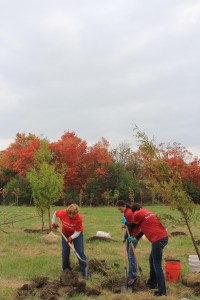Urban forestry.
The term itself seems contradictory. I used to gird myself when telling people what I do for a living. The inevitable bafflement would usually be followed by a pleasantly patronizing, “It’s nice you’re doing something you enjoy.”
I would never argue, though, because I really do enjoy this work. I enjoy its depth of impact that we are only beginning to understand, from improving air and water quality to influencing crime, obesity, psychology and energy, urban forestry encompasses a wide range of disciplines. Before becoming American Forests’ director of urban forest programs, I worked in the District of Columbia’s unique city-state structure. Any given day could have me collaborating on a multi-state analysis before being awoken at three in the morning to move a tree out of a major thoroughfare before rush hour.

Pro tip: Learn how to hide your saw before getting on the subway.
But that’s urban forestry in a nutshell, isn’t it? It’s knowing to look down rather than up to see whether a tree is sick long before its leaves show it or it tragically crashes into a home. It’s finding those opportunities to remove excess concrete and plant a tree — or ten. It is any vegetation that grows where large quantities of people live; the possibilities are endless.
Working in this field is like being in a fantasy world hidden in plain view. The first thing I notice when visiting any metro area is nature surging against all odds through the concrete and steel we have thrown upon it. Connecting people to nature where most don’t think nature exists — and making it all function like a wildland forest — is what keeps me motivated every day.
After emerging as a voice of reason amid the surging industrialism of the 19th century, American Forests followed people into cities, where we helped define the standards of arboriculture in the early 20th century. As early as the 1970s, we were organizing urban forestry conferences for this fledgling field. By the 1990s, we spearheaded a federal urban forestry program and pioneered GIS analyses of cities’ tree canopies that has helped attract many millions of dollars to help manage them. Today, amid our continuing work in cities nationwide, we are again pioneering new territory by finding or developing the next generation of innovations and best practices.
Written jointly with my colleague Bryant, our urban forestry posts will highlight such breakthroughs. We may look at a successful tree protection law one time and a nighttime tree planting dance party the next. We may explore how artists turn green spaces into meaningful and inspiring places. If you have ideas you think should be highlighted, feel free to let me know.